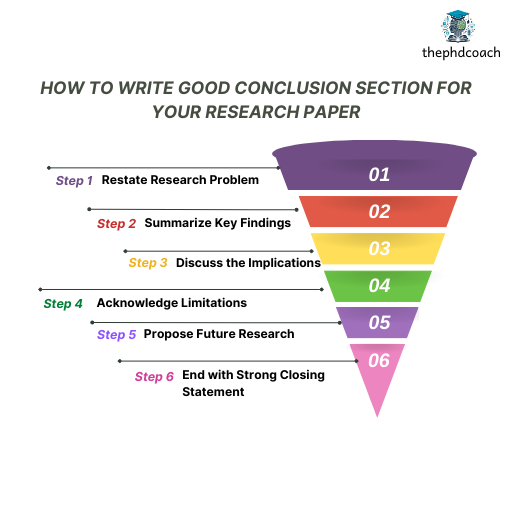
The conclusion section of a research paper is the final opportunity to leave a lasting impression on your readers. It’s where you summarize key findings, discuss their importance, and highlight future research opportunities. A well-structured conclusion doesn’t just end your paper; it adds value to your study and ensures that your research resonates with its audience. In this guide, we’ll break down six simple steps to help you write a strong conclusion for your research paper.
Restating the research problem is an essential part of any conclusion. It reminds readers of the central question you aimed to answer and reinforces the purpose of your study.
Why Restating the Problem is Important
Restating the problem sets the stage for summarizing your findings. It ensures that readers reconnect with the foundation of your research before delving into the closing remarks.
How to Restate Effectively
Example
If your research examined strategies to increase renewable energy adoption, you could restate the problem as follows:
“This study aimed to identify the key barriers to renewable energy adoption and explore strategies to address them.”
Summarizing your key findings is the next step. This helps readers understand the core contributions of your research without revisiting the entire paper.
Highlighting the Key Insights
Your conclusion should prioritize the most significant results, especially those that directly address your research question.
How to Present Your Findings
Example
“The findings revealed that public awareness campaigns and financial incentives significantly enhance renewable energy adoption rates, addressing the core barriers identified.”
Discussing the implications of your findings allows you to demonstrate their relevance beyond the scope of your study. It’s an opportunity to show how your work contributes to broader discussions in your field.
Why Implications Matter
Implications connect your research to real-world applications, theoretical advancements, or policy changes. They highlight why your findings are valuable and how they might be used.
Types of Implications
Example
“These findings provide policymakers with insights into designing subsidy programs that incentivize renewable energy usage while addressing public concerns.”
Acknowledging the limitations of your study builds credibility and transparency. Every study has its constraints, and discussing them shows that you understand the boundaries of your research.
Why It’s Important to Acknowledge Limitations
Being upfront about limitations provides context for your findings, helping readers assess their validity and applicability.
Common Limitations to Discuss
Example
“This study’s findings are limited by its small sample size, which restricts the generalizability of the results to larger populations.”
A good conclusion not only summarizes your research but also sets the stage for further studies. Proposing future research directions is a great way to highlight the gaps your study didn’t address.
How to Propose Future Research
Example
“Future studies should explore the role of cultural and regional factors in renewable energy adoption, as this research primarily focused on economic incentives.”
The final step is to craft a memorable closing statement that ties everything together. This is your last chance to leave an impression on your readers.
How to Create a Strong Closing
Example
“By addressing key barriers to renewable energy adoption, this study contributes to a more sustainable future and lays the groundwork for future academic and policy-driven advancements.”
Consider the following example of a strong conclusion:
“This study highlights the critical role of financial incentives and public awareness in driving renewable energy adoption. While limitations exist, such as the small sample size, the findings provide a foundation for policymakers to design targeted interventions. Future research should explore additional factors influencing adoption across diverse cultural contexts. Together, these efforts can accelerate the global transition to sustainable energy systems.”
Writing a strong conclusion is an essential part of any research paper. By following the six steps outlined above—restating the problem, summarizing findings, discussing implications, acknowledging limitations, proposing future research, and ending with a strong statement—you can craft a conclusion that leaves a lasting impression. A well-written conclusion not only ties your paper together but also reinforces the significance of your research in its field.
Q1: What is the main purpose of the conclusion in a research paper?
The conclusion summarizes your key findings, discusses their implications, and leaves readers with a strong closing message.
Q2: Can I include recommendations in the conclusion?
Yes, providing practical recommendations or proposing future research directions is encouraged.
Q3: How long should a research paper conclusion be?
A conclusion should be concise, usually 5-10% of the total word count.
Q4: Should I address limitations in my conclusion?
Yes, acknowledging limitations adds credibility and helps contextualize your findings.
Q5: What are common mistakes to avoid in writing conclusions?
Avoid repeating your introduction, introducing new information, or making vague or unclear statements.

Dr. Chopra is the founder and editor of thephdcoaches.blogs and Thephdcoaches Learn more about her here and connect with her on Instagram, Facebook and LinkedIn.
Dr. Tripti Chopra, founder of The PhD Coach, is an award-winning mentor and leader in integrating AI into academic research, with over a decade of experience guiding PhD students and researchers. Her work revolutionizes research processes, promotes sustainable writing practices, and inspires scholars to embrace technological advancements.
Copyright© 2023 Thephdcoach All rights reserved.